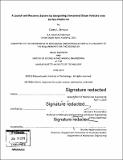A launch and recovery system for integrating unmanned ocean vehicles onto surface platforms
Author(s)
Strouse, Casey L.
Download1119389928-MIT.pdf (7.282Mb)
Other Contributors
Massachusetts Institute of Technology. Department of Mechanical Engineering.
Advisor
Michael S. Triantafyllou.
Terms of use
Metadata
Show full item recordAbstract
Unmanned vehicles (UxVs) are becoming more prevalent across all domains. As UxV technology improves and their operations become more essential to mission success, the challenge of integrating these vehicles onto current surface platforms becomes increasingly more important to solve. Surface ships are designed to be adaptive and meet the changing requirements of their operational environment over their 25-plus year life. However, the majority of the current surface fleet was not designed from the beginning for launch and recovery of unmanned ocean vehicles and must be retrofitted to support unmanned vehicle operations. While integration of UxVs will be limited by the size of the host platform, their integration should not be limited due to the inability to safely launch and recover them. This paper will analyze current manned launch and recovery systems across all naval surface platforms and present recommendations for improving these systems to be more adaptive to launching both manned and unmanned ocean vehicles. Specifically, this research will focus on minimizing the heave motions exhibited by the vehicle during launch and recovery. To achieve minimized heave motions and improve operational performance, an analysis was conducted to determine the feasibility, performance, and safety benefits of integrating an active heave compensating winch into the system.
Description
Thesis: Nav. E., Massachusetts Institute of Technology, Department of Mechanical Engineering, 2019 Thesis: S.M., Massachusetts Institute of Technology, Department of Mechanical Engineering, 2019 Cataloged from PDF version of thesis. Includes bibliographical references (pages 64-65).
Date issued
2019Department
Massachusetts Institute of Technology. Department of Mechanical EngineeringPublisher
Massachusetts Institute of Technology
Keywords
Mechanical Engineering.